From sea turtles to sooty falcons, dugongs to dolphins, Saudi Arabia’s NEOM is working to unlock the secrets of its unique underwater world and swell the population of rare species and sea life at the futuristic $500 billion mega business and tourism project.
The head of NEOM Nature Region, Dr Paul Marshall, told Al Arabiya English in an exclusive interview that a vast conservation effort is currently underway across the Red Sea and Gulf of Aqaba, with experts utilizing AI to track critical marine species native to the area, safeguard its extensive essential coral reefs, and accelerate planetary regeneration.
The Red Sea is untouched and one of the planet’s final frontiers. Located between Asia and Africa, its waters are essential to global trade and travel. Despite its rich ecosystem, the ocean bed remained largely uncharted.
Until now, that is.
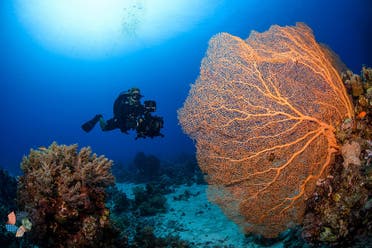
Uncovering the secrets of the Red Sea through advanced scientific exploration could make a dramatic difference to the battle to save the world’s oceans.
“NEOM Nature Reserve’s marine area is a globally and regionally important biodiversity hot spot,” explained Marshall. “Covering NEOM’s waters – the Red Sea and the Gulf of Aqaba – it is unique in high endemism, which is estimated in at least 14 percent of the more than 300 coral species found there and around 15 percent of the more than 1,100 fish species,” Marshall said.
NEOM’s waters are home to five species of turtles, nine species of dolphins, dugongs, whale sharks, intriguing creatures such as the havali guitarfish, and sharks and rays, amongst many others.
Key projects include sea turtle monitoring and satellite tagging, sooty falcon monitoring, tagging and nest enhancement, dedicated dugong surveys in identified hotspots, aerial surveys of megafauna using drones, boat-based surveys of dolphins, critical habitat work with corals and seagrass, fisheries assessments, and shark and ray baseline assessment.
“This work is important because it gives us a good understanding of the distribution and abundance of these critical species, it also helps in developing management plans to protect the species within the safe haven of the NEOM Nature Reserve,” said Marshall.
He said: “Our NEOM Nature Reserve Marine Conservation team is just beginning to unlock the secrets of this remarkable and unique underwater world, which is nearly two kilometers deep in places.”
Any development in NEOM undergoes a rigorous Environmental Impact Assessment process, with the project itself serving as a global hub of innovation and technology as it endeavors to build a global model for future living. This helps safeguard and protect NEOM’s wildlife, Marshall further explained.
Tracking rare species

As part of its conservation efforts, NEOM’s marine conservation team monitors key indicator species. This includes sea turtles, among the most ancient and diverse reptiles on the planet.
“NEOM is a crucial habitat for endangered and critically endangered turtles, including the Hawksbill and Green Turtles,” said Marshall. “In the past three years, we have satellite-tagged 17 turtles and identified over 600 nests. These tagged turtles have been observed traveling along the Red Sea coast, with one turtle covering a distance of over 500 kilometers and we are monitoring closely to establish movement patterns.”
NEOM has also established a Turtle Conservation Action Plan, which includes key initiatives, protecting crucial nesting beaches and associated habitats – coral reefs for the hawksbills and seagrass beds for the greens.
“This survey and management planning work support us in the achievement of our goal of maintaining and improving the number of turtles within NEOM Nature Reserve, now and into the future,” he said.
Monitoring programs
NEOM’s nature conservations are also tracking the dugong, an endangered species found along Saudi Arabia’s coastline.
Marshall said: “We have a population of dugongs who feed on our lush seagrass beds – nature’s underwater forests. We have in place a dedicated monitoring program in the hot spots where dugongs are found. The Red Sea is home to the third largest population of dugongs in the world. Many of these rare species are in NEOM. Within NEOM, we have completed aerial drone and boat-based surveys to understand this shy creature’s abundance and distribution.”
Marshall added: “We have focused on hot spots identified by our traditional fishing community, which are associated with seagrass beds and where feeding trails are evident.”
According to Marshall, this work is important because it helps achieve conversation goals and supports development of best practice guidelines and regulations for interactions between dugong, wildlife, and activities within the NEOM Nature Reserve.
Defending dolphins

One of nature’s favorite aquatic mammals is also in NEOM’s sight. There are about 40 species of dolphins in the world, nine of which can be found within NEOM’s waters, with the most common being the Common Bottlenose, Indo Pacific Bottlenose, and Spinner dolphin, famous for their acrobatics.
“Nearshore, we have the unique and endangered Humpback dolphin, shy creatures that frequent shallower areas in small family groups,” Marshall said.
For five years, NEOM has also been tracking the Sooty Falcon, a medium-sized falcon breeding from northeastern Africa to the southern Gulf region.
“We have devoted similar efforts towards the preservation of the Sooty Falcon. Between 2018 and 2023, we observed roughly 170 breeding pairs of Sooty Falcons in NEOM,” he told Al Arabiya English. “A recent study suggests approximately 431 breeding pairs reside within Saudi Arabia. Hence, NEOM is home to about 40 percent of the Kingdom of Saudi Arabia’s Sooty Falcons and nearly 12 percent of the global population,” he added.
“Our Sooty Falcon satellite data is really interesting. We have found that they reside in NEOM between May and November, where they breed and nest before embarking on an extraordinary 5,500 km journey to Madagascar, traversing the Red Sea and the African continent in a mere 14 days,” Marshall said.
“Similar to turtles, the completion of this work supports us in the achievement of our goal of maintaining and improving the number of Sooty Falcons within NEOM Nature Reserve, now and into the future. It also establishes NEOM as a leader in this field.”
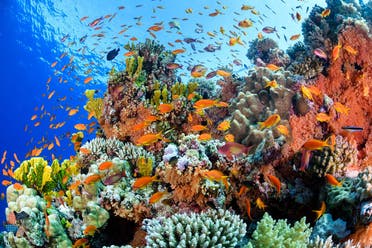
NEOM’S rich underwater sealife (Supplied: NEOM)
Other tracking systems in place have led to the NEOM conservation team identifying more than 1,100 fish species – with around 15 percent estimated as endemic.
“We are exploring an ecosystem approach to fisheries management and have begun meeting key stakeholders,” said Marshall. “We are on the way to completing a baseline stock assessment of NEOM’s fisheries. In addition, we have tagged fish and shark species within NEOM, some for the first time in the Red Sea. Establishing a baseline of sharks and rays is a priority moving forward,” Marshall further said.
Utilizing technology, AI
Marshall said in addition to traditional conservation techniques, technology is being deployed and developed continuously to make the monitoring efforts more efficient.”
He said one example is utilizing aerial drones to give NEOM an overview of its megafauna species – the likes of dugongs, dolphins, whale sharks, sharks, and turtles.
“We are working on embedding AI within these systems to support real-time decision-making within our reserve,” he said. “One of the things we really enjoy about our work is that we are unlocking the secrets of our underwater world and in many cases, the marine surveys we are doing now are being completed for the first time within NEOM and further afield.”

Corals in the Red Sea. (Supplied: NEOM)
He said every survey helps NEOM Nature Reserve ensure sustainable development and through that the vision of nature and people living in harmony is achieved.
“We have tagged Hawksbill and green turtles, Sooty Falcons, and five species of sharks within NEOM’s waters. This information helps us understand the movement of these species within NEOM and further afield, meaning we not only need to get the management of these species right within NEOM, but we also need to work with regional partners on protection and conservation efforts.”
Working with partners
The partners include King Abdullah University of Science and Technology (KAUST) – which has teamed up with NEOM on several conservation projects – and the renowned Ocean Explorer Research vessel, OceanX, the most advanced exploration, research and media vessel ever built to explore the habitats and species at depth in the vast waters around NEOM.
Over six weeks, 30 world-renowned experts at OceanX carried out pioneering work in the deep sea and shallow reefs – focused on oceanography, mapping and genetics. Their groundbreaking discoveries will lay the foundations for NEOM’s ambitious conservation program. This will protect the incredible biodiversity for generations to come. After 42 days spent 3D-mapping some 1,500 square km of seabed, the crew made some astounding discoveries. They found three ancient shipwrecks, surveyed three unexplored islands and identified eight areas of outstanding natural beauty. In addition, satellite tags were used to better understand marine life. Meanwhile, 152 sightings of megafauna resulted in the known range of species extending by more than 20.
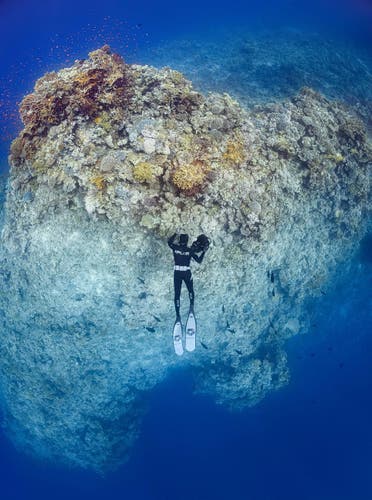
A NEOM and OCEAN X experiment in the Red Sea. (Supplied)
“We are grateful to our marine conservation program for some key collaborations. One of our valued delivery partners is KAUST, who is assisting us with our fieldwork in fish species, turtles, and sooty falcons. KAUST has a long track record in the Red Sea region,” explained Marshall. “We work with OceanX, a non-profit ocean exploration organization because they are the global leader in deep-sea marine research and monitoring.”
Protecting coral reefs
Marshall said, as part of the conservation project, work is also ongoing to track and monitor NEOM’s coral reefs and seagrass.
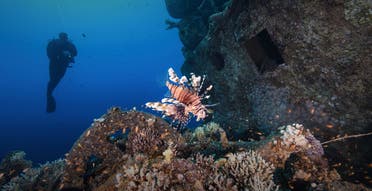
NEOM aims to create the world’s largest coral garden. (Supplied: NEOM)
With hundreds of millions of people relying on coral reefs for their livelihood, as well as their safety, given that reefs provide vital protection from storm and wave surges, corals are to the ocean what rainforests are to the land. Coral reefs’ tremendous diversity of plants and animals are a vital ecosystem – such as food for people around the world, habitat for economically valuable fish species, and sand for beaches. Yet, because of global warming, pollution and overfishing, reefs face a collection of serious threats.
A handful of years ago, a global ocean heat wave stressed corals, causing them to bleach and die off at tropical reefs worldwide. Yet, this did not happen at NEOM.
“NEOM’s marine area is often referred to as a natural climate change laboratory,” Marshall explained. “When the global coral bleaching event occurred recently, our corals were resilient with global bleaching having a limited impact within NEOM, compared to other global reefs around the world where there was up to 75 percent mortality.”
He further said: “NEOM might be one of the few places in the world where corals are found in the distant future because of the unique oceanographic characteristics of our waters. Accordingly, NEOM Nature Reserve is putting in efforts to ensure that our coral reef management and marine resilience program is at the forefront of innovation and research.”
NEOM Nature Reserve’s coral reef restoration work supports that of KAUST on Shusha Island within NEOM. The Shusha Island Project aims to create the world’s largest coral garden in the Red Sea. The project will cover 100 hectares on Shusha Island, which is located off the coast of the Tabuk province in northwestern Saudi Arabia.
The Shusha Island Coral Park will become a global center to showcase innovations that protect and restore coral reefs and marine organisms, accelerate conservation solutions, and reduce the effects of climate change. Expected to be completed by 2025, once finished, it will be a major tourist destination and a global hub for research and innovation in coral reef conservation.
Challenges in safeguarding marine life
Critical marine ecosystems that help maintain global oxygen and carbon cycles, produce food and energy, and sustain human wellbeing are swiftly being degraded due to the unsustainable use of marine environments and a rapidly changing climate.
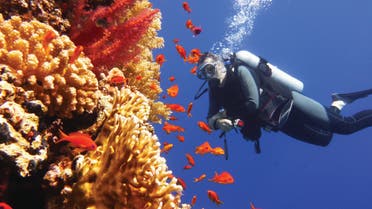
A diver in the Red Sea. (Supplied: NEOM)
Protecting the ocean has multiple effects, including safeguarding climate, food, and biodiversity. They also act as the planet’s greatest carbon sink and are home to nearly a million known species, containing vast untapped potential for scientific discovery. Its importance has repeatedly been highlighted by the United Nations, which, as part of its Sustainable Development Goals, highlights the need for a global pledge to protect at least 30 percent of the ocean by 2030. Despite healthy oceans and seas being essential to human existence and life on the planet, less than a tenth of the ocean is currently protected.
Marshall said NEOM is not immune to some of these challenges being faced across the planet, but aims to set a benchmark in marine conservation.
With the Red Sea probably one of the last thriving farming systems in the world, NEOM is taking key steps to not only safeguard its underwater ecosystem, but boost its biodiversity as well.
“For each of our threats, we have a well-developed roadmap to manage with innovation and technology at the core. With climate change, we see our coral reef research on restoration as a way to support international efforts.”
Sustainability across NEOM
NEOM, one of the world’s most ambitious sustainable urban developments, planned by Saudi Arabia’s Crown Prince Mohammed bin Salman, encompasses vertical city THE LINE, business hub Oxagon, luxury yachting destination Sindalah and the mountain resort of Trojena.
NEOM will also prioritize environmental conservation and regenerative development in its creative processes – focusing on restoration, repair, and rewilding to lead the renaissance of Arabian wildlife. Furthermore, nature reserves will safeguard flora, fauna, corals and wadis.
As part of its sustainability mission, NEOM has also launched its very own regreening initiative in collaboration with the National Center for Vegetation Cover and Combating Desertification.


